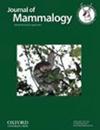洞穴麝(Myotis velifer)捕食多种猎物,并提供重要的生态系统服务
IF 1.6
3区 生物学
Q2 ZOOLOGY
引用次数: 0
摘要
食虫蝙蝠在自然生态系统中扮演着捕食者的重要角色,在农业景观中也有助于害虫控制。然而,使用传统方法很难确定特定蝙蝠物种的饮食特征,因为传统方法无法捕捉到详细的饮食信息。在这项研究中,我们利用细胞色素氧化酶 I 线粒体基因代谢编码技术分析了绒颚蝠的粪便样本,并从位于德克萨斯州奇瓦瓦沙漠地区的一个蝙蝠群中深入了解了蝙蝠饮食的季节性变化。在对序列读数进行过滤后,我们恢复并分析了绒颚贻贝饮食中的 706 个分子操作分类单元(MOTUs)。在 2021 年 3 月至 10 月收集的 66 份粪便样本中,我们发现了属于 11 个昆虫纲的 484 个分类群(种和属级)。含有最多MOTU的目是双翅目(353个)、鳞翅目(160个)和蜚蠊目(59个)。在它们的食物中,我们发现了重要的农作物害虫、非本地昆虫以及大量的蚊子。蝙蝠的食物组成随季节而变化。夏季捕获的蝙蝠摄食的节肢动物种类最多,而春季捕获的蝙蝠摄食的节肢动物种类较少。我们的研究结果发现了绒蝠会捕食的另外两种节肢动物--蜚蠊目和蜻蜓目,这两种节肢动物以前从未在绒蝠的食物中出现过。本文章由计算机程序翻译,如有差异,请以英文原文为准。
Cave Myotis (Myotis velifer) consume diverse prey items and provide important ecosystem services
Insectivorous bats play an essential role as predators in natural ecosystems and contribute to pest control in agricultural landscapes. However, characterizing diets of specific bat species is difficult using conventional methods that cannot capture detailed dietary information. In this study, we used metabarcoding of the cytochrome oxidase I mitochondrial gene to analyze fecal samples of Myotis velifer and provide insight into the seasonal variation of diet from a colony located in the Chihuahuan Desert region of Texas. After filtering sequence reads, we recovered and analyzed 706 molecular operational taxonomic units (MOTUs) in the diet of M. velifer. We found 484 taxa (species and genus level) belonging to 11 insect orders in 66 fecal samples collected from March to October 2021. The orders containing the most MOTUs were Diptera (n = 353), Lepidoptera (n = 160), and Blattodea (n = 59). In their diet, we identified important insect crop pests, non-native insects, and substantial consumption of mosquitoes. Dietary composition shifted throughout seasons. Bats captured in summer months consumed the highest diversity of arthropod orders, and those captured in the spring consumed more diet items but were less diverse in arthropod orders. Our results uncovered 2 additional orders consumed by M. velifer, Blattodea and Odonata, that have not been previously described in their diet.
求助全文
通过发布文献求助,成功后即可免费获取论文全文。
去求助
来源期刊

Journal of Mammalogy
生物-动物学
CiteScore
3.30
自引率
5.90%
发文量
106
审稿时长
4-8 weeks
期刊介绍:
Papers are published on mammalian behavior, conservation, ecology, genetics, morphology, physiology, and taxonomy.
 求助内容:
求助内容: 应助结果提醒方式:
应助结果提醒方式:


